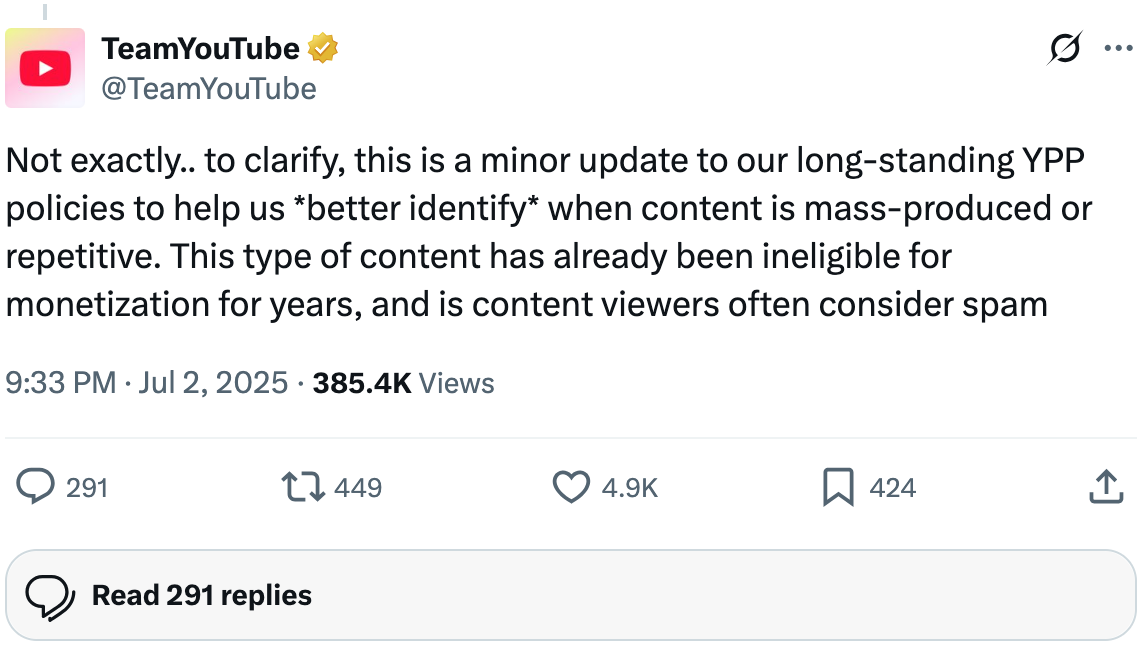Will YouTube Stop Monetizing AI‑Generated Videos? Best Practices for Creators in 2025
YouTube’s Current Position on AI
YouTube hasn’t officially restricted monetization for AI-generated videos, but it has reinforced its broader commitment to responsible AI use, transparency, and high-quality original content.
According to YouTube’s AI Principles, the platform uses AI to recommend and moderate content but requires creators to apply AI ethically and responsibly.
Creators must also follow YouTube’s Community Guidelines, which emphasize originality, value, and safety. AI content that fails to meet those standards may still be flagged or demonetized under existing policies.
Best Practices for Creators Using AI in 2025
Even without a formal policy, here’s how to keep your channel monetizable:
Add Your Own Voice or Commentary
Narrate the content or include on-camera presence. AI-generated footage must be transformed with original storytelling.
Invest in Unique Editing
Use your own B-roll, sound design, or overlays. Avoid generic AI templates or bulk uploads.
Disclose AI Assistance Transparently
Mention AI tools in descriptions when relevant, especially for educational or editorial transparency.
Use Legal Contracts to Manage AI Collaborations
Partnering with an editor or AI developer? Secure your rights via an Independent Contractor Agreement or a Content Licensing Agreement.
Stay on Top of Licensing and Ownership
Ensure you have the right to monetize AI-generated visuals or audio with a Digital Product Licensing check or Copyright Audit.
What YouTube May Flag as Low-Effort Content
YouTube’s policies already disqualify:
Reused, unedited stock footage
Narration-free listicles
Auto-read articles with no commentary
AI clips that mimic human creators without originality
Even if these aren’t banned under an “AI content” label, they violate existing monetization standards related to repetitive content and low educational value.
Legal Tools to Protect AI-Enhanced Channels
Content License Agreement Templates – clarify who owns what in your production
Gig & Influencer Agreements – outline scope and deliverables for voice actors, editors, or scriptwriters
Work-for-Hire Agreements – make sure your AI developer doesn’t retain rights to your monetized content
Privacy Policy & Website Terms – required if you gather data or use AI plug-ins on related websites
FAQs: YouTube and AI Monetization Rules
1. Can I still earn ad revenue from AI-enhanced videos?
Yes, if the video includes clear human effort, value, and originality.
2. Is there a risk to publishing AI-only content?
Yes. Even if not explicitly banned, such content may be flagged under “low-quality” or “re-used” policies.
3. Do I need to say I used AI?
No, but it’s encouraged in some niches. Transparency may enhance trust and credibility.
4. What’s the difference between “assisted” and “generated” AI content?
“Assisted” = AI helped you write or edit.
“Generated” = Content was entirely created by AI tools. The latter is more at risk.
5. Where can I see YouTube’s official policy?
Check the YouTube Community Guidelines and YouTube’s AI Practices for up-to-date details.
Final Takeaway
While YouTube hasn’t banned AI-generated content, it’s clear that creators must step up their game. AI is a tool, not a substitute for authentic storytelling, original editing, and strategic thinking.
As policies evolve, creators who embed legal, creative, and ethical best practices will lead the way. And with the right contracts, like Media Production Agreements, you’ll protect your monetization and your brand.


